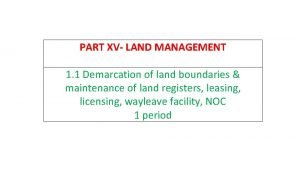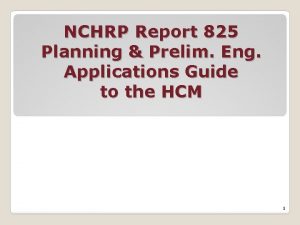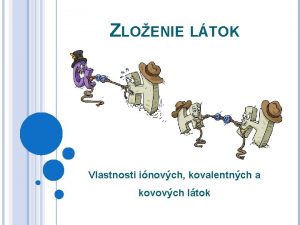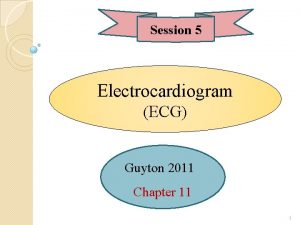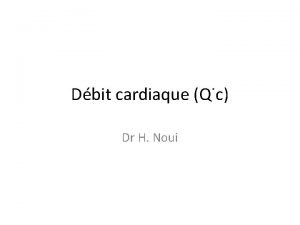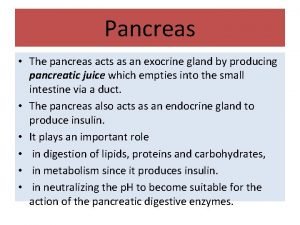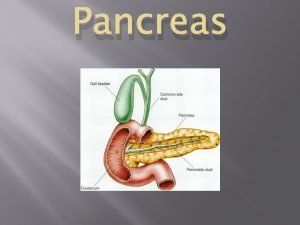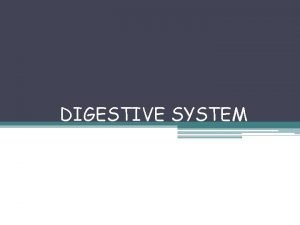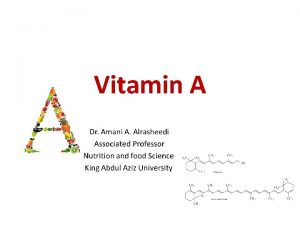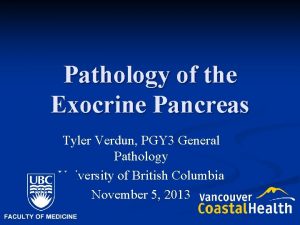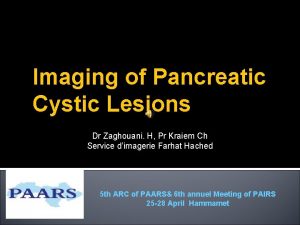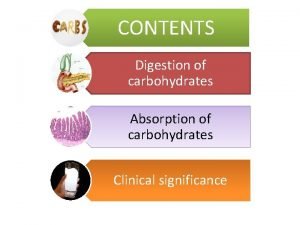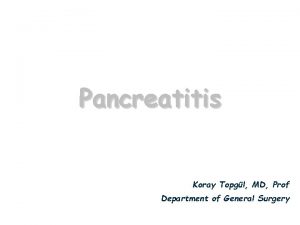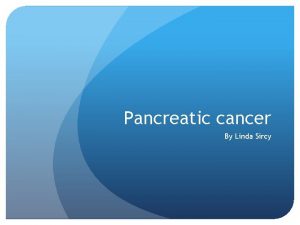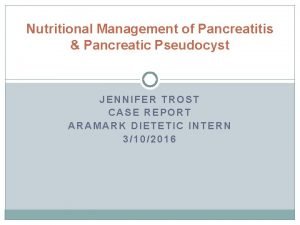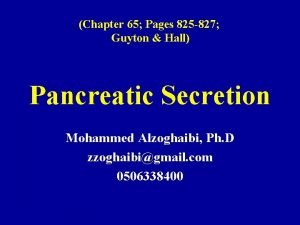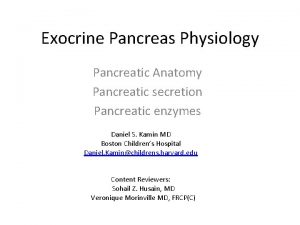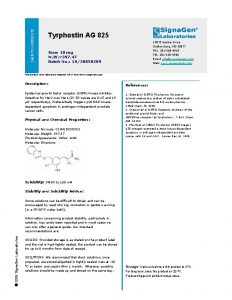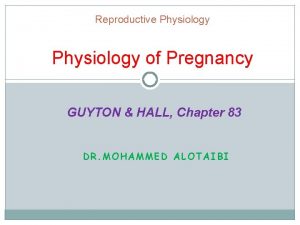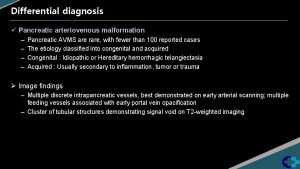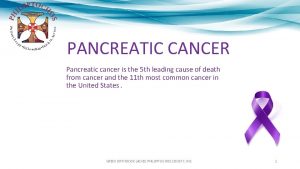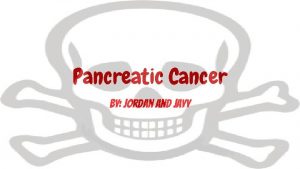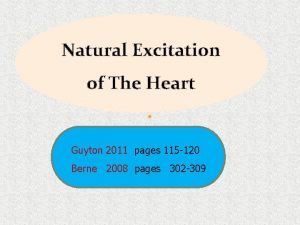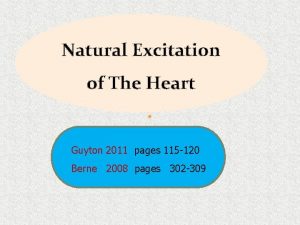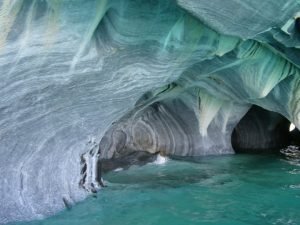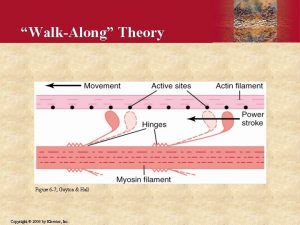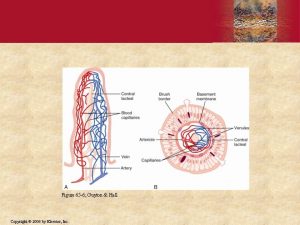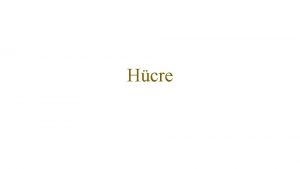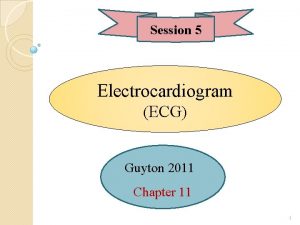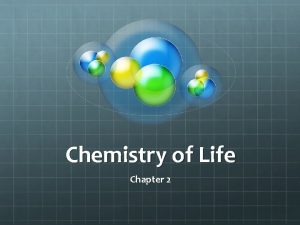Chapter 65 Pages 825 827 Guyton Hall Pancreatic


























- Slides: 26

(Chapter 65; Pages 825 -827; Guyton & Hall) Pancreatic Secretion Mohammed Alzoghaibi, Ph. D zzoghaibi@gmail. com 0506338400

Required Textbook Guyton & Hall Textbook of Medical Physiology Thirteenth Edition Published by Saunders Elsevier 2016

Pancreatic Secretion (Exocrine) Objectives: 1. Functional Anatomy 2. Major components of pancreatic juice and their physiologic roles 3. Cellular mechanisms of bicarbonate secretion 4. Cellular mechanisms of enzyme secretion 5. Activation of pancreatic enzymes 6. Hormonal & neural regulation of pancreatic secretion 7. Potentiation of the secretory response

Functional Anatomy • The pancreas, which lies parallel to and beneath the stomach is a large compound gland with most of its internal structure similar to that of the salivary glands

Islet of Langerhans in the pancreas. The pancreas, in addition to its digestive functions, secretes two important hormones: 1. Insulin (Beta cells; 60%). 2. Glucagon (Alpha cells; ~25%). that are crucial for normal regulation of glucose, lipid, and protein metabolism. Also Somatostatin is secreted by delta cells ( form ~10% of islets’s cells). Figure 79 -1. Copyright 2011, WB Saunders Elsevier, All Rights Reserved

Functional Anatomy (cont. ) • The pancreatic digestive enzymes are secreted by pancreatic acini, and large volumes of sodium bicarbonate solution are secreted by the small ductules and larger ducts leading from the acini. • Pancreatic juice is secreted in response to the presence of chyme in the upper portions of the small intestine.

Pancreatic Secretion • The major functions of pancreatic secretion: 1. 2. 3. To neutralize the acids in the duodenal chyme to optimum range (p. H= 7. 0 -8. 0) for activity of pancreatic enzymes. To prevent damage to duodenal mucosa by acid & pepsin To produce enzymes involved in the digestion of dietary carbohydrate, fat, and protein

Pancreatic secretion (continued) • Pancreatic secretions contain many enzymes for digesting proteins, carbohydrates, and fats, and large quantities of HCO 3 ions. • The most important pancreatic enzymes for digesting proteins are: 1. Trypsin. 2. Chymotrypsin. 3. Carboxypolypeptidase. • Trypsin and chymotrypsin split whole and partially digested proteins into peptides of various sizes but do not cause release of individual amino acids. • Carboxypolypeptidase splits some peptides into individual amino acids, thus completing digestion of some proteins to amino acids.

Pancreatic Enzymes (continued) When first synthesized in the pancreatic cells, the proteolytic digestive enzymes are in the inactive forms: 1. Trypsinogen 2. Chymotrypsinogen 3. Procarboxypolypeptidase These enzymes become activated only after they are secreted into the intestinal tract. 1. Trypsinogen is activated by: ● Enteropeptidase (enterokinase), an enzyme secreted by the intestinal mucosa when chyme comes in contact with the mucosa. ● Trypsinogen can be autocatalytically activated by trypsin formed from previously secreted trypsinogen. 2 & 3. Chymotrypsinogen and procarboxypolypeptidase are activated by trypsin to form chymotrypsin and carboxypolypeptidase.

Trypsin Inhibitor Secretion of Trypsin Inhibitor Prevents Digestion of the Pancreas Itself. ● Proteolytic enzymes of the pancreatic juice do not become activated until after they have been secreted into the intestine because the trypsin and the other enzymes would digest the pancreas itself. ● The same cells that secrete proteolytic enzymes into the acini of the pancreas secrete another substance called trypsin inhibitor, which is formed in the cytoplasm of the glandular cells, and it prevents activation of trypsin both inside the secretory cells and in the acini and ducts of the pancreas. ● Because trypsin activates the other pancreatic proteolytic enzymes, therefore trypsin inhibitor prevents activation of the other enzymes as well.

Activation of Trypsinogen in duodenal Lumen

Pancreatic secretion (continued) • The pancreatic enzyme for digesting carbohydrates is pancreatic amylase, which hydrolyzes starches, glycogen, and most other carbohydrates (except cellulose) to form mostly disaccharides and a few tri-saccharides.

Pancreatic secretion (continued) • The main enzymes for fat digestion are: (1)Pancreatic lipase (2) Cholesterol esterase (3) Phospholipase

Characteristics of Pancreatic Enzymes Enzyme Specific Hydrolytic Activity Proteolytic Endopeptidases Trypsin(ogen) Chymotrypsin(ogen) (Pro)elastase Exopeptidase (Pro)carboxypeptidase Amylolytic -Amylase Lipases Lipase (Pro)phospholipase A 2 Carboxylester hydrolase (cholesterol esterase) Nucleolytic Ribonuclease Deoxyribonuclease The suffix –ogen or prefix pro- indicates the enzyme is secreted in

Pancreatic secretions are rich in bicarbonate ions • The pancreas secrets about 1 L/day of HCO 3 –rich fluid from the epithelial cells of the ductules and ducts. • The osmolarity of pancreatic fluid is equal to that of plasma • HCO 3 concentration increases with increasing secretion rate

Secretion of Isosmotic Sodium Bicarbonate Solution.

Blood around the pancreas; acidic tide Secretion of Bicarbonate Ions From Pancreatic Ductal cell HCO 3 is exchanged for Cl. Secretin increases rate of exchange

Flow Rate and pancreatic secretion

Pancreatic Secretion is Under Neural and Hormonal Control • Parasympathetic stimulation (through Ach on acinar cells) results in an increase in enzyme secretion-fluid and HCO 3 • Secretin tends to stimulate a HCO 3 rich secretion by activating ductal cells. • CCK stimulates a marked increase in enzyme secretion by stimulating the acinar cells. • Pancreatic secretion normally results from the combined effects of the multiple basic stimuli, not from one alone (potentiate each other).

Stimuli for Pancreatic Secretion 1. Acetylcholine: released from the parasympathetic vagus nerve endings and from other cholinergic nerves in the enteric nervous system. 2. Cholecystokinin: secreted by the duodenal and upper jejunal mucosa (I cells) when food enters the small intestine. 3. Secretin: also secreted by the duodenal and jejunal mucosa (S cells) when highly acidic chyme enters the small intestine. Acetylcholine and cholecystokinin stimulate the acinar cells of the pancreas, causing production of large quantities of pancreatic digestive enzymes but relatively small quantities of water and electrolytes to go with the enzymes. Secretin, in contrast to the first two basic stimuli, stimulates secretion of large quantities of H 2 O and Na. HCO 3 solution by the pancreatic ductal epithelium.

Stimuli for Pancreatic Secretion (continued) Secretin Stimulates Secretion of Copious Quantities of Bicarbonate Ions—Neutralization of Acidic Stomach Chyme. ● Secretin is present in an inactive form, prosecretin (in S cells in the mucosa of the duodenum and jejunum). ● When acid chyme with p. H less than 4. 5 -5. 0 enters the duodenum from the stomach, it causes duodenal mucosal release and activation of secretin, which is then absorbed into the blood. ● Secretin causes the pancreas to secrete large quantities of fluid containing a high concentration of HCO 3 (up to 145 m. Eq/L = ~5 X normal) but a low concentration of Cl-. HCl + Na. HCO 3 → Na. Cl + H 2 CO 3 dissociates into CO 2 and H 2 O.

Stimuli for Pancreatic Secretion (continued) Cholecystokinin—Its Contribution to Control of Digestive Enzyme Secretion by the Pancreas. ● The presence of food in the upper small intestine causes cholecystokinin to be released from the I cells in the mucosa of the duodenum and upper jejunum. ● Release of cholecystokinin results especially from the presence of proteoses and peptones (products of partial protein digestion) and long-chain fatty acids in the chyme. ● Cholecystokinin, like secretin, passes by way of the blood to the pancreas and causes secretion of pancreatic digestive enzymes by the acinar cells. ● This effect is similar to that caused by vagal stimulation but even more pronounced, accounting for 70 -80% of the total secretion of the pancreatic digestive enzymes after a meal.

Regulation of Pancreatic Secretion

Multiplicative or Potentiation Effects of Different Pancreatic Secretion Stimuli ● When all different stimuli of pancreatic secretion (acetylcholine, cholecystokinin, and secretin) occur at once, then the total secretion is far greater than the sum of the secretions caused by each stimulus separately. The stimuli are said to “multiply” or “potentiate” one another. ● Usually, pancreatic secretions are the result of multiple stimuli rather than one stimulus.

Pancreatic secretion is phasic Phase stimulus Cephalic phase Smell, taste, chewing and swallowing Gastric phase Mediators Release of Ach Protein, gastric Vago-vagal distention reflex Intestinal phase Acid in chyme, fatty acids Secretin, CCK and vago-vagal reflex

The End
 Printed pages vs web pages
Printed pages vs web pages Para 827 of irwm
Para 827 of irwm Ohsu healthshare
Ohsu healthshare Nhcpr app
Nhcpr app Tentukan pbb dari 315 dan 825 dengan algoritma euclidean
Tentukan pbb dari 315 dan 825 dengan algoritma euclidean Latka s teplotou topenia 825
Latka s teplotou topenia 825 700 e yuvarlanan en küçük sayı
700 e yuvarlanan en küçük sayı Guyton
GuytonErythropoiesis guyton
 Ecg guyton
Ecg guyton Précharge postcharge
Précharge postcharge Differentiation of rbc
Differentiation of rbc Animal physiology definition
Animal physiology definition Guyton
Guyton Bile and pancreatic juices are secreted in the
Bile and pancreatic juices are secreted in the Enterokinase enzyme function
Enterokinase enzyme function Pancreas funzione
Pancreas funzione Digestion of carbohydrates ppt
Digestion of carbohydrates ppt Role of vitamin a
Role of vitamin a Normal pancreas histology
Normal pancreas histology Daughter mother grandmother pancreatic lesions
Daughter mother grandmother pancreatic lesions Content of pancreatic juice
Content of pancreatic juice Digestion of carbohydrates
Digestion of carbohydrates Absorption
Absorption Steatorrhea pictures
Steatorrhea pictures Stage 2b pancreatic cancer
Stage 2b pancreatic cancer Pancreatic pseudocyst diet
Pancreatic pseudocyst diet

